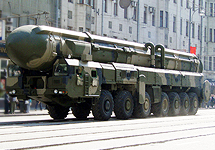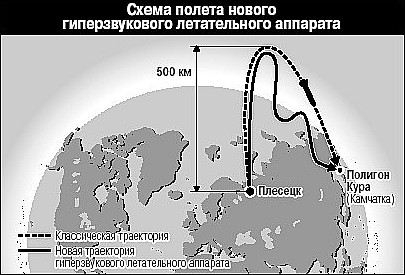Nikolai Sokov
November 9, 2005

Russian Topol Mobile Launcher,
Source: WikiMedia Commons
The November 1, 2005 test of a road-mobile Topol-M ICBM with a maneuverable warhead and a flow of new information about strategic modernization and deployment programs that was released simultaneously with that test shed light on the previously uncertain issue of the shape of the land leg of the Russian strategic triad. It is likely that in the future the ICBM force will consist of a mix of MIRVed silo-based Topol-M ICBMs with three warheads each and single-warhead road-mobile Topol-Ms boasting a maneuverable defense-penetrating warhead. MIRVing of the currently single-warhead silo-based Topol-M might, however, require an amendment to the 1991 START I Treaty. Such an amendment could be requested by Russia in the context of START I’s extension beyond 2009, the current expiration date.
The Test of Topol-M1 with Igla
On November 1, 2005 the Strategic Rocket Forces (SRF) conducted a flight test of a road-mobile ICBM Topol-M1 (a designation intended to distinguish it from the silo-based version known as Topol-M). Topol-M1 was officially adopted for deployment following a flight test earlier this year. The latest test stands out from a sequence of earlier tests of both versions of Topol-M for several reasons.
First, it involved the maneuverable warhead known as Igla for the first time — the only other flight test involving that warhead, in February 2004, was conducted from an earlier version of the missile, Topol, a.k.a. SS-25 (see the CNS Research Story “Military Exercises in Russia: Naval Deterrence Failures Compensated By Strategic Rocket Success”). Igla is supposed to be able to penetrate any existing or foreseeable missile defense because its trajectory changes unpredictably at the terminal phase of the flight (see the diagram of the trajectory of the first test of Igla).
Bits of new information have become available about that highly secretive warhead. Citing unnamed sources in the SRF, several Russian media outlets claimed that the trajectory of Igla is not just difficult but, in fact, impossible to predict because its auxiliary engines switch on and off randomly. The targeting system of the warhead itself is supposed to keep track of changes in the trajectory and eventually guide the warhead toward its target. Also, Igla reportedly utilizes “stealth” technology — a special coating makes it “invisible” to heat or electromagnetic impulses and thus more difficult to detect than ordinary warheads.

Trajectory of the first launch of Igla
The second unusual feature of the latest test was its trajectory. The missile was launched from the Kapustin Yar test range in Astrakhan region and targeted at the 10th test range at Lake Balkhash (a.k.a. Priozersk) in Kazakhstan. Since the breakup of the Soviet Union it has become standard to launch missiles from the Plesetsk test range in northern Russia to Kura in Kamchatka. Some media sources speculated that the choice of trajectory was dictated by the dwindling Russian capability to observe missiles during flight: the facilities available at Kura were insufficient to monitor the terminal phase of the flight. A complementary explanation is an attempt to deny the United States the opportunity to observe the new warhead.
The choice of a test range in Kazakhstan could also indicate that military cooperation between Russia and Kazakhstan might be closer than generally assumed. Previously, Kazakhstan often balked even at routine missile launches from the well-established Baikonur launch center.
New Information about the Future Russian Nuclear Posture
Speaking a few days before the Topol-M flight test, the Commander of the SRF, Gen. Nikolai Solovtsov, disclosed new information about Russian plans for the road-mobile ICBM and the ICBM force in general. Although his interview clarified some important points, it still fell short of a clear-cut deployment plan, leaving many elements of the future posture open to speculation.
(1) He said that deployment of road-mobile Topol-Ms will begin in 2006 with the transfer of the first wing (“divizion”) of three launchers to the 54th division in Teykovo (Ivanov oblast). Beginning in 2007, up to nine Topol-Ms will be deployed each year. (Nine launchers is the standard size of a regiment of road-mobile Topol ICBMs.)
The appropriations picture for 2006 seems reasonably clear and does not contain major surprises. Most likely, the SRF will receive four silo-based Topol-Ms for deployment, like in previous years (as was disclosed earlier this year, the plan is to deploy one 10-missile regiment of silo-based Topol-Ms every two and a half years) and three road-mobile missiles. This leaves no missiles for testing, however, whereas in the recent years Russia has conducted at least one Topol-M launch each year (typical purchases of Topol-Ms were six per year).
If, however, the plan to deploy one regiment of road-mobile ICBMs each year becomes a reality, this would indicate a serious change in the pattern established in 2000. In the summer of 2000 Vladimir Putin, acting on the advice of then-Chief of the General Staff Anatoliy Kvashnin, radically rearranged the strategic forces budget by sharply increasing funding for the navy and equally, if not more sharply, reducing allocations for the SRF. Whereas earlier plans called for the deployment of up to 20 Topol-Ms each year, the rate was reduced to first six and then ultimately four. A sharp increase of the deployment rate to 13 per year would mean that the SRF is restoring its role as the backbone of the strategic forces.
Two reasons might be behind such a policy change. The most obvious one is that accelerated funding for new SSBNs and SLBMs has paid off. The Bulava SLBM underwent its first flight test in September 2005 (the test was reported a success); construction of two SSBNs of the new Borey class is underway and the first submarine is expected to be launched in 2006. This might free some monies for ICBMs.
The other possible reason is that the Russian leadership has probably realized the challenge of meeting the 2002 Moscow Treaty’s limit on the number of warheads (1,700-2,200). Without accelerated deployment of ICBMs, Russia will most likely have no more than 1,200 warheads in 2013–a reduction even compared to the original Russian proposal for the Moscow Treaty, 1,500 (that proposal most likely reflected the actual future posture plans in 2001). Deployment of ICBMs is significantly cheaper than construction of submarines, and thus it is possible that a decision has been made to emphasize the land leg of the triad once again. Indirect evidence in favor of that explanation is the news about possible MIRVing (see below).
This will be good news for the Votkinsk plant, which has been operating below even its minimal capacity. With the deployment of 13 ICBMs each year, plus a possible additional one or two for testing, the plant’s prospects will significantly improve. If Bulava SLBMs are also produced in Votkinsk (the Bulava production facility has not been disclosed yet, although at least the engines for the SLBM were produced there), then it might even reach the cost-effective rate of production.
(2) According to Solovtsov, the maneuverable warhead, Igla, will be deployed both on Topol-Ms and on the future Bulava SLBM, whose first flight test was conducted last September. Until this statement it remained unclear how widespread Igla would become. It now appears that Russia intends to make the ability to penetrate missile defenses a high priority.
It remained unclear, however, whether all ballistic missiles of new types will be equipped with the maneuverable warhead. Igla is clearly bigger and heavier than an ordinary warhead and, consequently, Bulava, which is widely reported as intended to carry ten warheads, will hardly be able to carry the same number of Igla’s. It seems likely that Solovtsov meant only road-mobile Topol-Ms; similarly, only some of the new SLBMs will be equipped with maneuverable warheads.
(3) Solovtsov also disclosed for the first time that the Moscow Institute of Thermal Technology, which designed both Topol-M and Bulava, was working on MIRVing Topol-M. Until his statement, this remained little but speculation; now it has become a certainty.
Although widely expected, the MIRVing of Topol-M will represent a significant milestone in Russia’s nuclear policy. Moscow agreed to a long-standing US proposal to ban MIRVed ICBMs under the 1993 START II Treaty. This was as much a response to US pressure as a recognition of the fact that Russia could no longer rely on cooperation with Ukraine, where all latest-generation MIRVed ICBMs had been built. START II did not enter into force, however, and Russia announced it null and void the day after the United States formally withdrew from the 1972 ABM Treaty in June 2002. This step laid the legal groundwork for the future MIRVing of ICBMs: according to the Vienna Convention on the Law of Treaties, it could not take steps that would contravene the treaty between its signing and entry into force. By declaring START II null and void, Russia removed that legal obstacle.
Two important questions remain after Solovtsov’s interview. First, whether both versions of Topol-M will be MIRVed or only one of them and, second, whether MIRVed missiles will carry Igla warheads. It seems likely that only silo-based ICBMs will carry more than one warhead and that the Igla-carrying road-mobile version of Topol-M will remain single-warhead.
MIRVing will help Russia reach or at least approach the lower Moscow Treaty level of 1,700 warheads. Even with the current deployment rate, Russia will have about 120 silo-based Topol-Ms, which, with three warheads apiece, will constitute 360 warheads. By the second half of 2010s, when the last of the SS-19 ICBMs will have to be eliminated, Topol-M will indeed constitute the backbone of the land leg of the triad. The SRF will feature silo-based MIRVed ICBMs with three warheads each and single-warhead mobile ICBMs with defense-penetrating warheads. Overall, this posture could be quite survivable.
Potential Problems with the Extension of the START I Treaty
The possibility that Topol-M will be MIRVed has important implications for the future of the 1991 START I Treaty, which expires in December 2009. It has been widely assumed that START I will be extended–a highly desirable development since it is now the only treaty that provides transparency and verification mechanisms (the Moscow Treaty is, by and large, unverifiable).
START I, however, prohibits parties from increasing the number of warheads on existing types of ICBMs. To declare the silo-based Topol-M a new missile type, Russia might need to undertake an expensive series of tests and, even worse, make the missile sufficiently different from Topol-M. The Russian military has for a long time privately complained about the unnecessarily restrictive nature of some START I provisions, including the one that prevents the MIRVing of Topol-M. It seems likely that Russia will want to change the relevant START I provisions, using extension as a convenient pretext. The issue will likely be first raised within the JCIC (Joint Compliance and Inspection Commission) and if JCIC is unable to resolve the issue (which is likely because it would amount to an amendment and require proper ratification procedures) will seek to amend START I as a condition of its extension.
Notes
(1) “S Poligona Kapustin Yar Osushchestvlen Pusk Ballisticheskoi Rakety,” Strana Ru, November 1, 2005, www.strana.ru.
(2) “Topol-M Vsekh Sil’nei,” Nezavisimaya Gazeta, October 28, 2005.
(3) “Moskva Ispytala Assimetrichnyi Otvet,” Kommersant-Daily, November 2, 2005.
(4) “Minoborony: Topol-M Smozhet Preodolet’ Protivoraketnuyu Oboronu SShA, Grani.Ru, November 2, 2005, www.grani.ru.
(5) Olga Boah’eva, “Topolinyi Pukh-Pakh,” Moskovskii Komsomolets, November 3, 2005.
(6) “Tem Vremenem v Rossii…” Nezavisimaya Gazeta, November 3, 2005.
